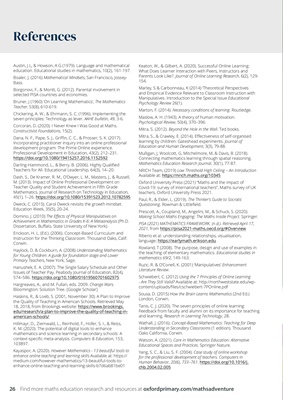
Find more maths education research and resources at oxfordprimary.com/mathsadventure
26
Austin, J L, & Howson, A G (1979). Language and mathematical
education. Educational studies in mathematics, 10(2), 161-197.
Boaler, J. (2016) Mathematical Mindsets, San Francisco, JosseyBass.
Borgonovi, F., & Montt, G. (2012). Parental involvement in
selected PISA countries and economies.
Bruner, J (1960) 'On Learning Mathematics', The Mathematics
Teacher, 53(8), 610-619.
Chickering, A. W., & Ehrmann, S. C. (1996). Implementing the
seven principles: Technology as lever. AAHE bulletin, 49, 3-6.
Corcoran, D. (2020). I Never Knew I Was Good at Maths.
Constructivist Foundations, 15(2).
Dana, N. F., Pape, S. J., Griffin, C. C., & Prosser, S. K. (2017).
Incorporating practitioner inquiry into an online professional
development program: The Prime Online experience.
Professional Development in Education, 43(2), 212-231.
https://doi.org/10.1080/19415257.2016.1152592
Darling-Hammond, L., & Berry, B. (2006). Highly Qualified
Teachers for All. Educational Leadership, 64(3), 14-20.
Dash, S., De Kramer, R. M., O'Dwyer, L. M., Masters, J., & Russell,
M. (2013). Impact of Online Professional Development on
Teacher Quality and Student Achievement in Fifth Grade
Mathematics. Journal of Research on Technology in Education,
45(1), 1-26. https://doi.org/10.1080/15391523.2012.10782595
Dweck, C. (2015). Carol Dweck revisits the growth mindset.
Education Week, 35(5), 20-24.
Domino, J. (2010) The Effects of Physical Manipulatives on
Achievement in Mathematics in Grades K-6: A Metaanalysis (Ph.D.
Dissertation, Buffalo, State University of New York).
Erickson, H. L. (Ed.). (2006). Concept-Based Curriculum and
Instruction for the Thinking Classroom. Thousand Oaks, Calif:
Corwin.
Haylock, D. & Cockburn, A. (2008) Understanding Mathematics
for Young Children: A guide for foundation stage and Lower
Primary Teachers, New York, Sage.
Hanushek, E. A. (2007). The Single Salary Schedule and Other
Issues of Teacher Pay. Peabody Journal of Education, 82(4),
574-586. https://doi.org/10.1080/01619560701602975
Hargreaves, A., and M. Fullan, eds. 2009. Change Wars.
Bloomington: Solution Tree. [Google Scholar]
Haskins, R., & Loeb, S. (2001, November 30). A Plan to Improve
the Quality of Teaching in American Schools. Retrieved May
18, 2018, from Brookings website: https://www.brookings.
edu/research/a-plan-to-improve-the-quality-of-teaching-inamerican-schools/
Hillmayr, D., Ziernwald, L., Reinhold, F., Hofer, S. I., & Reiss,
K. M. (2020). The potential of digital tools to enhance
mathematics and science learning in secondary schools: A
context-specific meta-analysis. Computers & Education, 153,
103897.
Kayaspor, A. (2020). However Mathematics - 13 beautiful tools to
enhance online teaching and learning skills Available at: https://
medium.com/however-mathematics/13-beautiful-tools-toenhance-online-teaching-and-learning-skills-b7d6ab81be01
Keaton, W., & Gilbert, A. (2020). Successful Online Learning:
What Does Learner Interaction with Peers, Instructors and
Parents Look Like?. Journal of Online Learning Research, 6(2), 129-
154.
Marley, S & Carbonneau, K (2014) 'Theoretical Perspectives
and Empirical Evidence Relevant to Classroom Instruction with
Manipulatives. Introduction to the Special Issue Educational
Psychology Review 26(1).
Marton, F. (2014). Necessary conditions of learning. Routledge.
Maslow, A. H. (1943). A theory of human motivation.
Psychological Review, 50(4), 370-396.
Mitra, S. (2012). Beyond the Hole in the Wall. Ted books.
Mitra, S., & Crawley, E. (2014). Effectiveness of self-organised
learning by children: Gateshead experiments. Journal of
Education and Human Development, 3(3), 79-88.
Mulligan, J, Woolcott, G, Mitchelmore, M, & Davis, B. (2018).
Connecting mathematics learning through spatial reasoning.
Mathematics Education Research Journal, 30(1), 77-87.
NRICH Team, (2019) Low Threshold High Ceiling - An Introduction
Available at: https://nrich.maths.org/10345
Oxford University Press (2021) "Maths and the impact of
Covid-19: survey of international teachers", Maths survey of UK
teachers, Oxford University Press 2021.
Paul, R., & Elder, L. (2019). The Thinker's Guide to Socratic
Questioning. Rowman & Littlefield.
Prescott, A., Coupland, M., Angelini, M., & Schuck, S. (2020).
Making School Maths Engaging: The Maths Inside Project. Springer.
PISA (2021) MATHEMATICS FRAMEWORK. (n.d.). Retrieved April 17,
2021, from https://pisa2021-maths.oecd.org/#Overview
Riberio et al: understanding relationships, visualisation,
language; https://earlymath.erikson.edu
Rowland, T (2008). The purpose, design and use of examples in
the teaching of elementary mathematics. Educational studies in
mathematics 69/2, 149-163.
Ruzic, R. & O'Conell, K. (2001) 'Manipulatives' Enhancement
Literature Review.
Schwiebert, C. (2012) Using the 7 Principles of Online Learning
- Are They Still Valid? Available at: http://northweststate.edu/wpcontent/uploads/files/cschwiebert-7POnline.pdf
Sousa, D. (2015) How the Brain Learns Mathematics (2nd Ed.)
London, Corwin.
Tanis, C. J. (2020). The seven principles of online learning:
Feedback from faculty and alumni on its importance for teaching
and learning. Research in Learning Technology, 28.
Wathall, J. (2016). Concept-Based Mathematics: Teaching for Deep
Understanding in Secondary Classrooms (1 edition). Thousand
Oaks California, Corwin.
Watson, A. (2021). Care in Mathematics Education: Alternative
Educational Spaces and Practices. Springer Nature.
Yang, S. C., & Liu, S. F. (2004). Case study of online workshop
for the professional development of teachers. Computers in
Human Behavior, 20(6), 733-761. https://doi.org/10.1016/j.
chb.2004.02.005
References